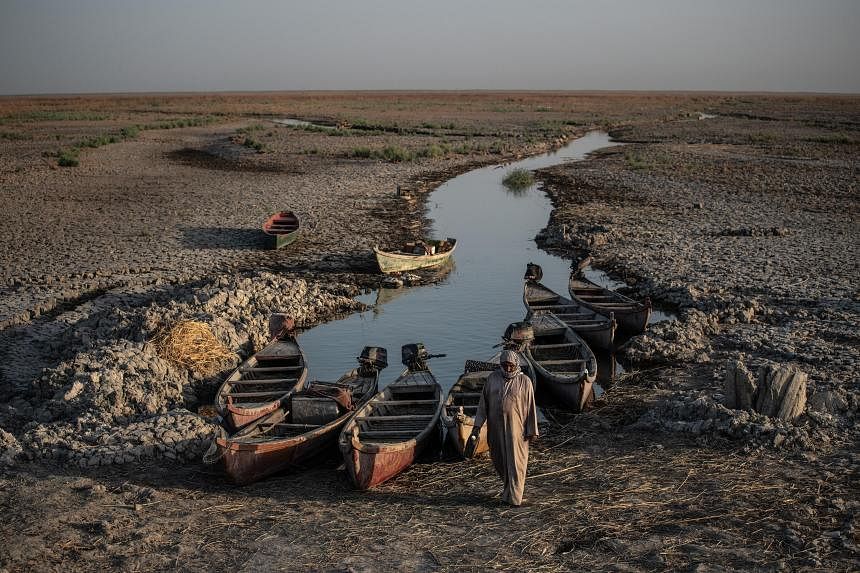BEIRUT – Human-made climate change is driving a years-long extreme drought in Iran, Iraq and Syria, an area that encompasses a region known as the Fertile Crescent and a cradle of civilisation, scientists said on Wednesday.
The scientists stressed that years of conflict and political instability combined with the challenges of rapid urbanisation in the region have limited the ability of local communities to respond to the drought, transforming it into a humanitarian crisis.
In the last three years, the drought, the second worst on record, has shrivelled wheat crops and led to tensions between neighbouring countries and communities over access to dwindling water supplies. It has also displaced tens of thousands of people and helped push millions into hunger.
The crisis is evidence of how global warming caused by the burning of fossil fuels can act “as a threat multiplier,” said Ms Rana El Hajj, a technical adviser at the Red Cross Red Crescent Climate Centre in Lebanon and one of the 10 authors of the study. It was put out by the World Weather Attribution initiative, an international scientific collaboration that specialises in rapid analysis of extreme weather events.
The drought, she added, “is just an indication of a reality which could affect vulnerable groups across the globe as human-induced challenges, including environmental degradation and conflict, can compound the increasing risk of climate change to yield unprecedented impacts”.
The researchers studied the effects of climate change on the low rains and high temperatures experienced by the Fertile Crescent, the region around the Euphrates and Tigris rivers, and Iran, between July 2020 and June 2023. Although the study was not peer-reviewed, the findings are based on standardised methods that have been.
The researchers found that the warming caused by the burning of fossil fuels did not significantly affect rainfall but made the high temperatures that continue to bake the region 16 times as likely in Iran and 25 times as likely in Iraq and Syria.
Such heat would have been “virtually impossible without climate change”, said Dr Ben Clarke, one of the authors of the study and a researcher at the Grantham Institute for Climate Change and the Environment at Imperial College London.
High temperatures cause dry conditions because they increase evapotranspiration, or how much water evaporates from the soil, water bodies and plants. Combined with lack of rainfall, it’s what experts call an “agricultural drought”.
In a hypothetical world where humans had not released huge amounts of heat-trapping gases into the atmosphere, the weather conditions in the region analysed by the study would be so much less severe that they would not be considered a drought at all, the researchers said.
“One thing is very, very clear, though, that this is already touching the limits of what some people are able to adapt to,” said Dr Friederike Otto, one of the authors of the study and a senior lecturer in climate science at the Grantham Institute. “As long as we keep burning fossil fuels or even give out new licences to explore new oil and gas fields, these kinds of events will only get worse.”
The Middle East is among the regions that are most vulnerable to the effects of climate change. It has suffered from almost continuous drought since 1998, though rainfall in 2020 brought some respite. Still, a large part of its population depends on rain to nurture wheat crops and provide drinking water to livestock.
The effects of climate change have been compounded not only by political instability, but also by weak governance over water sources and reliance on wasteful irrigation techniques across the region. A growing population with rising water needs as well as rapid urbanisation are adding more pressure to the region’s insufficient water infrastructure.
In Iraq, 61 per cent of households faced water shortages, according to a survey published in 2022 that was led by the Norwegian Refugee Council, an aid group. One-fifth of respondents said they had run out of water entirely.
Iran, the region’s largest producer of wheat, was forced to increase imports after the drought led to large crop failures in 2022. Food prices skyrocketed in the country, even as the war in Ukraine had already fuelled food inflation around the world.
In Syria, an 11-year war and economic meltdown combined with the drought to push 12 million people into hunger, according to the International Rescue Committee, a non-profit humanitarian group. The crowding of communities around whatever water sources remain also led to cholera outbreaks.
The climate is unlikely to bring any respite. Extreme drought is no longer a rare event in a world that is 1.2 deg C warmer than in pre-industrial times. It is now expected to happen at least every decade in the Euphrates River basin and at least twice a decade in Iran.
The current dry conditions are expected to continue, said Dr Mohammad Rahimi, a professor of climatology at Iran’s Semnan University and another of the study’s authors. Projections of the future, he added, indicate that “Syria, Iraq and Iran will become even harsher places to live”. NYTIMES
Water will be key issue at COP28 climate talks, says Dutch envoy
askST: What is COP28, and why is it an important conference?
Join ST’s Telegram channel and get the latest breaking news delivered to you.
p.st_telegram_boilerplate:before {
display: inline-block;
content: ” “;
border-radius: 6px;
height: 6px;
width: 6px;
background-color: #12239a;
margin-left: 0px;
margin-right: 13px;
}
a.st_boilerplate {
font-family: “SelaneWebSTForty”, Georgia, “Times New Roman”, Times, serif;
}


